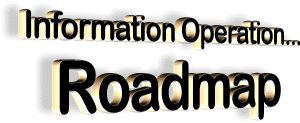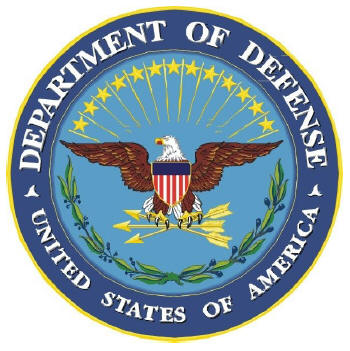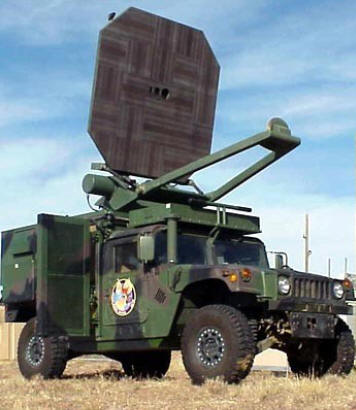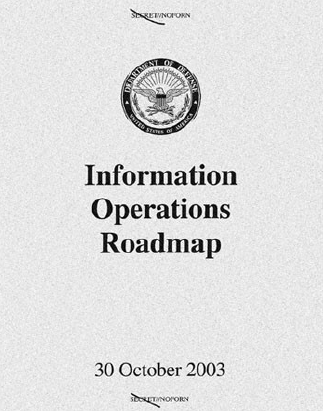
by Brent Jessop
from
DandelionSalad-WordPress Website
Part 1
Full Spectrum Information Warfare
December 17, 2007

When the US military refers to full spectrum
domination, they truly mean full spectrum.
Information operations or information warfare is
a key part of the military battlespace. Recently, a document entitled
Information Operation Roadmap was declassified by the Pentagon because of a
Freedom of Information Act request by the National Security Archive at
George Washington University.
The document was described by the
Council on
Foreign Relations’ website as:
“A 2003 Pentagon document previously
classified as ‘noforn’ (not for release to foreign nationals, including
allies), this report details the US military’s information operations,
including psychological operations, electronic warfare, and involvement
in foreign journalism. The document was made public by the National
Security Archive on January 26, 2006.”
On Par with Air, Ground, Maritime and Special
Operations
The importance of information warfare
is clearly laid out in this document.
“Key assumptions. Information, always
important in warfare, is now critical to military success and will only
become more so in the foreseeable future.
Three key assumptions underscore the growing
importance of information:
- (U) Effectively communicating U.S.
Government (USG) capabilities and intentions is an important means
of combating the plans of our adversaries. The ability to rapidly
disseminate persuasive information to diverse audiences in order to
directly influence their decision-making is an increasingly powerful
means of deterring aggression.” – 3
The major thrust of the document was that
information operations should be centralized under the Office of the
Secretary of Defense and made a core military competency.
“Objective: IO [information operations]
becomes a core competency. The importance of dominating the information
spectrum explains the objective of transforming IO into a core military
competency on a par with air, ground, maritime and special operations.
The charge to the IO Roadmap oversight panel was to develop as concrete
a set of action recommendations as possible to make IO a core
competency, which in turn required identifying the essential
prerequisites to become a core military competency.” – 4
Uniformity in Message and Themes
The major reason for centralizing the
information operations under a single command was to create consistency
between the various segments of the Pentagon’s information operations.
“IO requires coordination with public
affairs and civil military operations to complement the objectives of
these related activities and ensure message consistency.” – 23
“- (U) The USG [US Government] can not
execute an effective communication strategy that facilitates
military campaigns if various organs of Government disseminate
inconsistent messages to foreign audiences. Therefore, it is
important that policy differences between all USG Departments and
Agencies be resolved to the extent that they shape themes and
messages.
- (U) All DoD [Department of Defense] information activities,
including information operations, which are conducted at the
strategic, operational, and tactical level, should reflect and be
consistent with broader national security policy and strategy
objectives.” – 25
“Coordinating information activities. Major
DoD “information activities” include public affairs, military support to
public diplomacy and PSYOP [psychological operations].
The State
Department maintains the lead for public diplomacy, the [half line
redacted] and the International Broadcasting Board of Governors
maintains the lead for broadcasting USG messages overseas, often with DoD in a supporting role.
DoD has consistently maintained that the
information activities of all these agencies must be integrated and
coordinated to ensure the promulgation of consistent themes and
messages.” – 25
A Trained and Ready Career Force
With the ascension of information operations into a core military competency
the document recommended, under the heading “A Trained and Ready Career
Force” that the:
“DoD [Department of Defence] requires a
cadre of IO professionals capable of planning and executing fully
integrated IO in support of Combatant Commanders. An IO career force
should be afforded promotion and advancement opportunities commensurate
with other warfighting areas and provided opportunities for advancement
to senior executive or flag level rank.” – 32
Support
The forward of this document was signed by then Secretary of Defense Donald
H. Rumsfeld which contained the following statement of support:
“I approve the Roadmap recommendations and
direct the Services, Combatant Commands and DoD Agencies to fully
support implementation of this plan.” – iv
What Are Information Operations?
This document defined information
operations as follows:
“The integrated employment of the core capabilities of Electronic
Warfare, Computer Network Operations, Psychological Operations, Military
Deception and Operations Security, in concert with specified supporting
and related capabilities, to influence, disrupt, corrupt or usurp
adversarial human and automated decisions-making while protecting our
own.” – 22
Part 2
The Pentagon’s Electronic Warfare Program: Maximum
Control of the Entire Electro-Magnetic Spectrum
December 24, 2007
In 2003, then Secretary of Defense Donald Rumsfeld signed a document called
the
Information Operation Roadmap
which outlined, among other things, the
Pentagon’s desire to dominate the entire electromagnetic spectrum.
If you are unfamiliar with this document, more detail can be found in a
previous article above.

Dominate
From Information Operation Roadmap:
“We Must Improve Network and
Electro-Magnetic Attack Capability. To prevail in an information-centric
fight, it is increasingly important that our forces dominate the
electromagnetic spectrum with attack capabilities.” – 6
“Cover the full range of EW [Electronic Warfare] missions and
capabilities, including navigation warfare, offensive counterspace,
control of adversary radio frequency systems that provide location and
identification of friend and foe, etc.” – 61
“Provide a future EW capability sufficient to provide maximum control of
the entire electromagnetic spectrum, denying, degrading, disrupting, or
destroying the full spectrum of globally emerging communication systems,
sensors, and weapons systems dependant on the electromagnetic spectrum.”
– 61
“DPG [Defense Planning Guidance] 04 tasked USD (AT&L) [Under Secretary
of Defense for Acquisition, Technology and Logistics], in coordination
with the CJCS [Chairman of the Joint Chiefs of Staff] and Services, to
develop recommendations to transform and extend EW capabilities, … to
detect, locate and attack the full spectrum of globally emerging
telecommunications equipment, situation awareness sensors and weapons
engagement technologies operating within the electromagnetic spectrum.”
– 59
Stealthy Platforms Above Your House
“Develop a coherent and comprehensive EW
[Electronic Warfare] investment strategy for the architecture that… Pay
particular attention to:
- (U) Projecting electronic attack into
denied areas by means of stealthy platforms… As a matter of
priority, accelerates joint development of modular EW payloads for
the Unmanned Combat Aerial Vehicle.” – 62
It is interesting to see the mention of
stealthy platforms like unmanned aerial vehicles (UAVs) because they are
now patrolling both the Canadian and Mexican borders of the United
States and will soon be patrolling the arctic. With funding supplied by
Homeland Security, US police departments are also using UAVs to spy on
the citizens below. A couple of examples are Sacramento, California and…
“one North Carolina county is using a UAV equipped with low-light and
infrared cameras to keep watch on its citizens. The aircraft has been
dispatched to monitor gatherings of motorcycle riders at the Gaston
County fairgrounds from just a few hundred feet in the air–close enough
to identify faces–and many more uses, such as the aerial detection of
marijuana fields, are planned.”
The Electronic Battlespace
“The ACTD [Advanced Concept Technology
Demonstration] should examine a range of technologies including a
network of unmanned aerial vehicles and miniaturized, scatterable public
address systems for satellite rebroadcast in denied areas. It should
also consider various message delivery systems, to include satellite
radio and television, cellular phones and other wireless devices and the
Internet.” – 65
“Exploits other transformational EW initiatives, including use of the
E-Space Analysis Center to correlate and fuse all available data that
creates a real time electronic battlespace picture.” – 62
How exactly do you create a real time electronic battlespace picture? And where exactly is
the battlespace?
A very similar statement was made in the
Project
for a New American Century document Rebuilding America’s Defenses published
in September of 2000.
“New classes of sensors – commercial and
military; on land, on and under sea, in the air and in space – will be
linked together in dense networks that can be rapidly configured and
reconfigured to provide future commanders with an unprecedented
understanding of the battlefield.” – pg 59
An article written by
Mark Baard from
Parallelnormal.com sheds some light on this subject.
“Philadelphia, San Francisco, Houston, and
Providence, R.I. are among the cities partnering with private companies
and the federal government to set up public broadband internet access.
Providence used Homeland Security funds to construct a network for
police, which may be made available to the public at a later date…”
“But even if the cities fail to complete their Wi-Fi projects, the
military will be able to set up wireless networks within hours, perhaps
even faster.”
“The DOD [Department of Defense], which is in the middle of joint urban
war-games with Homeland Security and Canadian, Israeli and other
international forces, is experimenting with Wi-Fi networks it can set up
on the fly.”
“According to a recent DOD announcement for contractors, soldiers will
be able to drop robots, called LANdroids… when they arrive in a city.
The robots will then scurry off to position themselves, becoming nodes
for a wireless communications network. (Click here to download a PDF of
the DOD announcement.)”
“The Wi-Fi antennae dotting the urban landscape will serve not only as
communications relays, but as transponders that can pinpoint the exact
positions of of individual computers and mobile phones – a scenario I
described in the Boston Globe last year.”
“In other words, where GPS loses site of a device (and its owner), Wi-Fi
will pick up the trail.”
“The antennae will also relay orders to the brain-chipped masses,
members of the British Ministry of Defense and the DOD believe.”
Conclusion
My next article will examine the Pentagon’s desire to “fight the net” as
outlined in the Information Operation Roadmap.
Also, I will examine the use of psychological
operations or PSYOP and highlight the complete lack of limits to the use of
all these information operations, be it on domestic American or foreign
audiences.
Part 3
“We Must Fight the Net”
December 24, 2007
The Pentagon’s
Information Operation Roadmap
is blunt about the fact that
an internet, with the potential for free speech, is in direct opposition to
their goals. The internet needs to be dealt with as if it were an enemy
“weapons system”.
The 2003 Pentagon document entitled the Information Operation Roadmap was
released to the public after a Freedom of Information Request by the
National Security Archive at George Washington University in 2006.

A detailed explanation of the major thrust of
this document and the significance of information operations or information
warfare was described in above reports.
Computer Network Attack
From Information Operation Roadmap:
“When implemented the recommendations of
this report will effectively jumpstart a rapid improvement of CNA
[Computer Network Attack] capability.” – 7
“Enhanced IO [information operations] capabilities for the warfighter,
including: … A robust offensive suite of capabilities to include
full-range electronic and computer network attack…” – 7
Would the Pentagon use its computer network
attack capabilities on the Internet?
Fighting the Net
“We Must Fight the Net. DoD [Department of
Defense] is building an information-centric force. Networks are
increasingly the operational center of gravity, and the Department must
be prepared to “fight the net.” – 6
“DoD’s “Defense in Depth” strategy should operate on the premise that
the Department will “fight the net” as it would a weapons system.” – 13
It should come as no surprise that the Pentagon
would aggressively attack the “information highway” in their attempt to
achieve dominance in information warfare.
Donald Rumsfeld’s involvement in the Project for
a New American Century sheds more light on the need and desire to control
information.
PNAC Dominating Cyberspace
The Project for a New American Century (PNAC) was founded in 1997 with many
members that later became the nucleus of the
George W. Bush administration.
The list includes:
-
Jeb Bush
-
Dick Cheney
-
I. Lewis Libby
-
Donald Rumsfeld
-
Paul Wolfowitz,
...among many other powerful but less well know
names.
Their stated purpose was to use a hugely
expanded U.S. military to project “American global leadership.” In September
of 2000, PNAC published a now infamous document entitled
Rebuilding America's Defenses. This document has a very similar theme as the Pentagon’s
Information Operations Roadmap which was signed by then Secretary of Defense
Donald Rumsfeld.
From Rebuilding America’s Defenses:
“It is now commonly understood that
information and other new technologies… are creating a dynamic that may
threaten America’s ability to exercise its dominant military power.” – 4
“Control of space and cyberspace. Much as control of the high seas – and
the protection of international commerce – defined global powers in the
past, so will control of the new “international commons” be a key to
world power in the future. An America incapable of protecting its
interests or that of its allies in space or the “infosphere” will find
it difficult to exert global political leadership.” – 51
“Although it may take several decades for the process of transformation
to unfold, in time, the art of warfare on air, land, and sea will be
vastly different than it is today, and “combat” likely will take place
in new dimensions: in space, “cyber-space,” and perhaps the world of
microbes.” – 60
For more on Rebuilding America’s Defenses
read
this.
Internet 2
Part of the Information Operation
Roadmap’s plans for the internet are to “ensure the graceful degradation of
the network rather than its collapse.” (pg 45) This is presented in
“defensive” terms, but presumably, it is as exclusively defensive as the
Department of Defense.
As far as the Pentagon is concerned the internet is not all bad, after all,
it was the Department of Defense through DARPA that gave us the internet in
the first place. The internet is useful not only as a business tool but also
is excellent for monitoring and tracking users, acclimatizing people to a
virtual world, and developing detailed psychological profiles of every user,
among many other Pentagon positives.
But, one problem with the current internet is
the potential for the dissemination of ideas and information not consistent
with US government themes and messages, commonly known as free speech.
Naturally, since the plan was to completely dominate the “infosphere,” the
internet would have to be adjusted or replaced with an upgraded and even
more Pentagon friendly successor.
In an article by Paul Joseph Watson of Prison Planet.com, he describes the
emergence of Internet 2.
“The development of “Internet 2″ is also
designed to create an online caste system whereby the old Internet hubs
would be allowed to break down and die, forcing people to use the new
taxable, censored and regulated world wide web. If you’re struggling to
comprehend exactly what the Internet will look like in five years unless
we resist this, just look at China and their latest efforts to
completely eliminate dissent and anonymity on the web.”
Conclusion
The next article will examine the Pentagon’s use of psychological operations
or PSYOP and the final article in this series will examine whether or not
there are any limits to using information operations on the American public
or foreign audiences.
Part 4
Information Warfare Using Aggressive PsychOps
December 24, 2007
The Pentagon’s plans for psychological operations or PSYOP in the global
information environment of the 21st century are wide ranging and aggressive.
These desires are outlined in the 2003 Pentagon document signed by Donald Rumsfeld in his capacity as the Secretary of Defense called the
Information Operation Roadmap.
More detail about the origins and purpose of this document can be read in
the first part of this series well above.

Also, a description of the Pentagon’s desire to
dominate the entire electro-magnetic spectrum and their need to “fight the
net” as outline in the Information Operation Roadmap were previously
described.
What is a PSYOP?
A PSYOP is not specifically defined in
this document but it does provide some insight into the wide ranging
activities that are considered PSYOP.
“The customary position was that “public
affairs informs, while public diplomacy and PSYOP influence.” PSYOP also
has been perceived as the most aggressive of the three information
activities, using diverse means, including psychological manipulation
and personal threats.” – 26
“One result of public affairs and civil military operations is greater
support for military endeavors and thus, conversely these activities can
help discourage and dissuade enemies, which PSYOP does more directly
with its own tactics, techniques and procedures.” – 10
“PSYOP messages disseminated to any audience except individual
decision-makers (and perhaps even then) will often be replayed by the
news media for much larger audiences, including the American public.” –
26
“A PSYOP force ready to conduct sophisticated target-audience analysis
and modify behaviour with multi-media PSYOP campaigns featuring
commercial-quality products that can be rapidly disseminated throughout
the Combatant Commanders area of operations.” – 63
“PSYOP products must be based on in-depth knowledge of the audience’s
decision-making processes and the factors influencing his decisions,
produced rapidly at the highest quality standards, and powerfully
disseminated directly to targeted audiences throughout the area of
operations.” – 6
“Better depiction of the attitudes, perceptions and decision-making
processes of an adversary. Understanding how and why adversaries make
decisions will require improvements in Human Intelligence (HUMINT) and
open source exploitation, as well as improved analytic tools and
methods.” – 39
“SOCOM [Special Operations Command] should create a Joint PSYOP Support
Element to coordinate Combatant Command programs and products with the
Joint Staff and OSD [Office of the Secretary of Defense] to provide
rapidly produced, commercial-quality PSYOP product prototypes consistent
with overall U.S. Government themes and messages.” – 15
“SOCOM’s ongoing PSYOP Advanced Concept Technology Demonstration and
modernization efforts should permit the timely, long-range dissemination
of products with various PSYOP delivery systems. This includes
satellite, radio and television, cellular phones and other wireless
devices, the Internet and upgrades to traditional delivery systems such
as leaflets and loudspeakers that are highly responsive to maneuver
commanders.” – 15
“PSYOP equipment capabilities require 21st Century technology. This
modernization would permit the long-range dissemination of PSYOP
messages via new information venues such as satellites, the Internet,
personal digital assistants and cell phones:
- (U) PSYOP ACTD. Commencing in FY04,
SOCOM [Special Operations Command] initiates an Advanced Concept
Technology Demonstration (ACTD) to address dissemination of PSYOP
products into denied areas.
The ACTD should examine a range of
technologies including a network of unmanned aerial vehicles and
miniaturized, scatterable public address systems for satellite
rebroadcast in denied areas. It should also consider various message
delivery systems, to include satellite radio and television,
cellular phones and other wireless devices and the Internet.” – 65
“Rapid, fully integrated nodal and network
analysis providing Combatant Commanders with holistic kinetic and
non-kinetic solutions for a full range of electromagnetic, physical and
human IO [information operations] targets.” – 39
“Capabilities such as physical security, information assurance, counter
intelligence and physical attack make important contributions to
effective IO.” – 23
Third Party PSYOP
The Pentagon is also willing to use
third parties for their PSYOP.
“Identify and disseminate the views of third
party advocates that support U.S. positions. These sources may not
articulate the U.S. position the way that the USG [US Government] would,
but that may nonetheless have a positive influence.” – 27
Under recommendation number 48 – “Create a Joint PSYOP Support Element”
– is the following:
“Contract for commercial sources for enhanced product development.” – 64
The use of third party advocates or front groups
for the dissemination of US government propaganda is well documented. A
couple of recent examples include the illegal payment of $1.6 billion for
domestic fake news and similar activities in Iraq using the Lincoln Group
among others.
Virtual PSYOP
Not only is the Pentagon exploiting
new and old technology for aggressive behavior modification, they can also
practice and refine their techniques in a virtual simulation of the entire
world.
From an article by Mark Baard:
“U.S defense, intel and homeland security
officials are constructing a parallel world, on a computer, which the
agencies will use to test propaganda messages and military strategies.”
“Called the Sentient World Simulation, the program uses AI routines
based upon the psychological theories of Marty Seligman, among others.
(Seligman introduced the theory of “learned helplessness” in the 1960s,
after shocking beagles until they cowered, urinating, on the bottom of
their cages.)”
“Yank a country’s water supply. Stage a military coup. SWS will tell you
what happens next.”
“The sim will feature an AR avatar for each person in the real world,
based upon data collected about us from government records and the
internet.”
-
How useful do you think your new MySpace or
Facebook account is in helping the Pentagon develop a detailed psychological
profile of you?
-
Do you think they would be shy in exploiting such a valuable
source of personal data?
AIDS Awareness
"PSYOP in the past, however, often was
used to support U.S. Government public diplomacy and information objectives
with non-adversarial audiences. These actions include counter-drug, demining
and
AIDS awareness programs in friendly countries.” – 25
It is a minor point in the context of this document, but it is worth
reflecting on why US military PSYOP were used for AIDS awareness.
Are There Any Limits to Information Warfare?
An obvious question arises from the
description of PSYOP described by the Information Operation Roadmap,
-
Are there any limits?
-
Can PSYOP be conducted on the American
public or just foreign audiences?
-
On adversaries or non-adversaries?
-
Can they be performed during peacetime?
My next article (below) will attempt to show
just how few limits there actually are.
Big Brother is watching you online
Everything you post is being saved and
recorded in a national database file on you. They’re called profiles for
a reason. With facial recognition software and Google Street view
camera they know where you are all the time.
FACEBOOK
Federal Human Data Mining Program
Part 5
Information Warfare Without Limits
December 24, 2007
The 2003 Pentagon document entitled Information Operation Roadmap describes
the need to dominate the entire electromagnetic spectrum, ‘fight the net‘,
and use psychological operations to aggressively modify behavior.
But one
major question remains: are there any limits to information warfare?
If you are unfamiliar with the Information Operation Roadmap please read a
previous article I wrote describing the major thrust of this document.

PSYOP, Public Diplomacy and Public Affairs
From 'Information Operation Roadmap':
“In the past some basic similarities and
dissimilarities between PSYOP [psychological operations], support to
public diplomacy and public affairs generally have been accepted.
Historically all three used truth to bolster credibility, and all three
addressed foreign audiences, both adversary and non-adversaries.
Only public affairs addressed domestic
audiences. In addition, all three activities sought a positive impact
for USG [US Government] interests, but with some differences in the
methods employed and objectives sought. The customary position was that
“public affairs informs, while public diplomacy and PSYOP influence.”
PSYOP also has been perceived as the most
aggressive of the three information activities, using diverse means,
including psychological manipulation and personal threats.” – 26
There is a lot happening in this paragraph.
-
First, there is the almost humorous statement; “truth to bolster
credibility”. Does anyone remember WMDs, Saddam and 9/11,
maybe some uranium from Niger? Do you believe these examples of public
affairs were to inform or influence?
-
Secondly, “USG interests” are by no means the same as the interests of the
average American.
-
Thirdly, the concept that only public affairs is being
addressed to domestic audiences, is simply absurd given the ability of
information to pass across borders.
This document even admits as much:
“Impact of the global village. The
increasing ability of people in most parts of the globe to access
international sources makes targeting particular audiences more
difficult.
Today the distinction between foreign and
domestic audiences becomes more a question of USG [US Government] intent
rather than information dissemination practices:
PSYOP is restricted by both DoD
[Department of Defense] policy and executive order from targeting
American audiences, our military personnel and news agencies or
outlets… However, information intended for foreign audiences,
including public diplomacy and PSYOP, increasingly is consumed by
our domestic audience and vice-versa…
PSYOP messages disseminated to any
audience except individual decision-makers (and perhaps even then)
will often be replayed by the news media for much larger audiences,
including the American public.” – 26
So there you have it,
“the distinction between foreign and
domestic audiences becomes more a question of US government intent
rather than information dissemination practices”.
Therefore, the American public is fair game for
all forms of US government propaganda, be it, public affairs, public
diplomacy or PSYOP.
Remember, PSYOP use,
“diverse means, including psychological
manipulation and personal threats” among many other things.
It should also be highlighted that PSYOP are
only restricted not prohibited from being used on the American public. If
that loophole is not large enough, the distinctions between the tactics of
public affairs, public diplomacy and PSYOP are elaborated in
Appendix C of
the Information Operation Roadmap.
The very last task listed for PSYOP is:
“when called upon, support to local public
affairs activities”.
Appendix C of this document is well worth the
one page read (pg 71). Some other highlight include:
Public Affairs:
“Rapid Response/Truth Squads and “Briefings Plus” “
“Humanitarian road shows”
“Media embeds”
“Combat Camera products on events not accessible to news media”
Public Diplomacy:
“Content of speeches or OP/ED pieces by senior DoD [Department of
Defense] officials to foreign audiences”
“Talking points for private exchanges with foreign leaders”
“Overt dissemination of USG [US Government] policy. e.g. Asia-Pacific
Forum”
PSYOP:
“Radio/TV/Print/Web media designed to directly modify behavior and
distributed in theatre supporting military endeavors in semi or
non-permissive environments”
“When called upon, support to theatre public diplomacy”
“DoD advisors to assist friendly forces in developing PSYOP programs”
Changing Definitions
Definitions are another great tool if
you are trying to deceive. As described above the definitions of and
distinction between public affair, public diplomacy and PSYOP are left
intentionally vague.
Lawyers make a living out of this type of deception and
their hands are all over this document.
“PSYOP should focus on support to military
endeavors (exercises, deployments and operations) in non-permissive or
semi-permissive environments (i.e. when adversaries are part of the
equation).
- (U) However, PSYOP forces and
capabilities may be employed to support U.S. public diplomacy as
part of approved theatre security cooperation guideline. In this
case PSYOP personnel and equipment are not conducting a PSYOP
mission, but rather are providing military support to public
diplomacy.” – 27
Get that?
If PSYOP forces and equipment are used
in support of military endeavours, it is a PSYOP mission. If PSYOP forces
and equipment are used in support of public diplomacy, it is public
diplomacy.
A Quick Recap
A close read of the above quotes reveal that information operations,
specifically PSYOP, can be used on both domestic and foreign audiences, in
non-permissive or semi-permissive environments, and on adversary and
non-adversary.
Are there any other limits?
Peace, Crisis and War
“The Department’s concept of IO [information
operations] should emphasize full spectrum IO that makes a potent
contribution to effects based operations across the full range of
military operations during peace, crisis and war.” – 7
“Peacetime preparation. The Department’s IO concept should emphasize
that full-spectrum information operations are full-time operations
requiring extensive preparations in peacetime… Well before crises
develop, the IO battlespace should be prepared through intelligence,
surveillance and reconnaissance and extensive planning activities…
Similarly, considerable effort should be made to characterize potential
adversary audiences, and particularly senior decision-makers and
decision-making processes and priorities. If such human factors analysis
is not conducted well in advance of the conflict, it will not be
possible to craft PSYOP themes and messages that will be effective in
modifying adversary behavior” – 8
“Clear, unambiguous and streamlined DoD [Department of Defense]
oversight and policy that empowers Combatant Commanders to execute full
spectrum IO before, during and after combat operations.” – 20
Denied Areas
“Improvements in PSYOP capability are
required to rapidly generate audience specific, commercial-quality
products into denied areas.” – 26
“Projecting electronic attack into denied areas by means of stealthy
platforms.” – 62
Conclusion
Does the Pentagon define any real limits to information warfare? Information
operations can be used on both domestic and foreign audiences, in
non-permissive or semi-permissive environments, on adversary and
non-adversary, during peace, crisis and war, and in denied areas.
Should we really expect anything less?
They did tell us that their goal was full
spectrum dominance.





